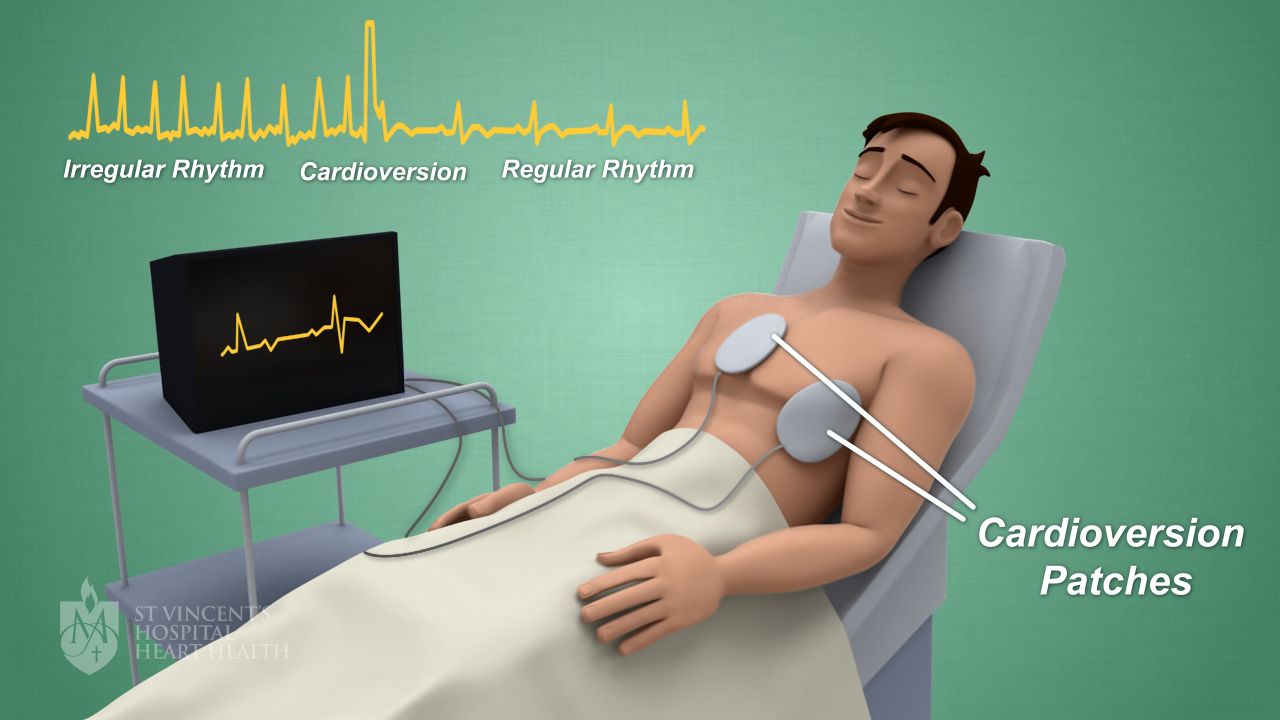Cardioversion
A cardioversion is a procedure that helps to restore an irregular heartbeat to a normal heart rhythm.
What is a cardioversion?
Why do I need a cardioversion?
What are the risks of having a cardioversion?
How do I prepare for a cardioversion?
What happens during a cardioversion?
What happens after a cardioversion?
What is a cardioversion?
A cardioversion procedure helps to correct irregular heart rhythms (arrhythmias). It’s a short procedure that uses an electrical current to bring your heart rhythm back to normal.
This image below shows a cardioversion.


Why do I need a cardioversion?
There are two common types of arrhythmias: atrial fibrillation, and atrial flutter. In both types, the upper chambers of your heart (atria) beat very fast, or “quiver”. Less commonly, your lower chambers of your heart (ventricles) may also beat very fast or “quiver”. The aim of the cardioversion is to electrically reset the hearts abnormal rhythm.
When your heart beats too fast, it can’t pump enough blood to the rest of your body. As a result, you may feel symptoms like:
- Dizziness or blackouts
- Shortness of breath
- Tiredness
- Chest pain
If you have arrhythmias, your doctor will probably give you medication as a first step. Not all arrhythmias can be corrected with medication alone, though.
What are the risks of having a cardioversion?
A cardioversion is usually a safe procedure, and serious problems are unlikely. There is a small risk of blood clots that may travel from your heart to your body. Your medical team will be aware of this, and they’ll give you blood thinning medication to help prevent this from happening. Sometimes cardioversions don’t work and patients need other therapies to restore their heart rhythm.
How do I prepare for a cardioversion?
Your doctor will tell you what you need to do to prepare for your cardioversion. It’s common to:
- Fast (not eat or drink anything) for 6 hours before the procedure. If you take SGLT2 medicine for diabetes, you will need to stop taking them at least 3 days before your surgery. Read our Patient Information Guide on SGLT2 inhibitors for diabetes.
- Take medication to help prevent blood clotting
- Possibly have a TOE procedure, which can check for any blood clots in your heart
What happens during a cardioversion?
A cardioversion is short and straightforward, and takes just a few minutes. During the procedure:
- Sticky pads will be put on your chest (men may need their chests shaved to help these stick)
- You’ll be connected to a machine that monitors your heart rhythm
- You’ll be given medication to make you sleep (you’ll be asleep for the whole procedure)
- After you’ve fallen asleep, one or more low-energy electric currents will be sent your heart
- Each current lasts less than a second
- You won’t feel any pain at all
What happens after a cardioversion?
When your cardioversion is finished, you’ll be closely watched by your medical team for several hours. As you’ll have been asleep during the procedure, you’ll probably feel drowsy for a little while afterwards. Some patients have sensitive skin at the site where the sticky pads are placed for the cardioversion.
Remember, always follow your post-treatment instructions. This will include not driving or operating heavy machinery for 24 hours after your procedure, and taking some medication to reduce blood clots and keep your heart rhythm normal. Information and guidelines can also be found in our Cardioversion for Atrial Fibrillation Patient Information sheet.
After your cardioversion, your doctor will make a follow-up appointment with you to discuss your ongoing treatment and put a suitable management plan into place.